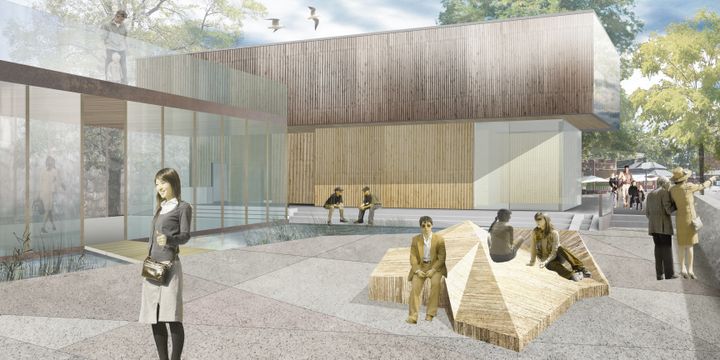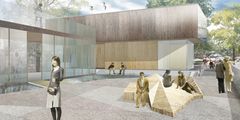Almost ready: Baltic Sea Science Center to open on 11 April

In 2015, Skansen and BalticSea2020 began cooperating on improving the opportunities for the Baltic Sea to thrive in the future. This cooperation lead to the idea of a science centre for both the public and schools, featuring interactive exhibitions, the chance to look beneath the surface of the Baltic Sea in the form of enormous aquariums, and inspiring learning spaces with a laboratory. Construction began in autumn 2016, and a final push is now under way in preparation for the grand opening.
The Baltic Sea is a unique inland sea. The mixture of freshwater and saltwater creates an environment unlike any other in the world. The freshwater from watercourses mixes with seawater from the Atlantic, and the resulting balance provides the perfect conditions for a variety of plants and creatures. The Baltic Sea is also the local environment for more than 90 million people. With time, problems relating to eutrophication, overfishing and environmental toxins have grown increasingly serious, and information, political decisions and collaboration are needed in order to reverse the trend.
The Baltic Sea Science Center at Skansen is one part of the puzzle, together with a number of long-term efforts and initiatives in many different areas. The work of the Baltic Sea Science Center is being planned in consultation with a knowledge council consisting of representatives from the Swedish University of Agricultural Sciences, Stockholm University and the BalticSea2020 Foundation.
The knowledge council guarantees that all communication will be based on scientific fact, and will be updated in line with new research. The knowledge council will continue its work after the centre opens in April 2019, taking responsibility for essential external monitoring and ensuring that relationships with the rest of the research community – and with other players, both nationally and internationally – are an integral part of the work of the centre. The aim is to create a world-class pedagogical centre, to give visitors an insight into the state of the Baltic Sea beneath the surface, and to show us all what we can do about the problems.
Images

About Stiftelsen Skansen
Skansen is a unique place where history meets the present day. Skansen is the world’s oldest open-air museum, showcasing the whole of Sweden with houses and farmsteads from every part of the country. It is also the world’s only open-air museum with wild animals. Here you can see Nordic wildlife, rare breeds, pets and exotic creatures visit the Skansen Aquarium and the Children´s zoo and from April 12 2019 the Baltic Sea Science Center.
Subscribe to releases from Stiftelsen Skansen
Subscribe to all the latest releases from Stiftelsen Skansen by registering your e-mail address below. You can unsubscribe at any time.
Latest releases from Stiftelsen Skansen
Tjolahopp! Nu blir det hyss och skoj på Skansen24.4.2024 07:55:00 CEST | Pressmeddelande
-Den här majhelgen har blivit en riktig tradition och vi är så glada att återigen få bjuda in stockholmarna till Skansen för att träffa Pippi och alla de andra från Astrid Lindgrens värld, säger Max Hallén, VD, Astrid Lindgren Aktiebolag.
Saint-Gobain utökar sitt engagemang i Stiftelsen Skansen18.4.2024 12:00:00 CEST | Pressmeddelande
Saint-Gobain har varit en partner till Skansen sedan 1991. Det är nu klart att de kliver in och utökar sitt engagemang under de kommande tre åren. ”Bevarandet av ett kulturarv rimmar väldigt väl med ett hållbart byggande som är vår ledstjärna inom Saint-Gobain”, säger Annika Westby på Saint-Gobain Sweden.
Uje Brandelius är årets vårtalare på Skansen: “Jag gråter alltid på Valborg”17.4.2024 07:50:00 CEST | Pressmeddelande
Den 30 april firar Skansen traditionsenligt valborg med livemusik, valborgsmässobål till stans bästa utsikt över Stockholm och klassiskt tal till våren. Musikern, skådespelaren och journalisten Uje Brandelius får i år det traditionstunga uppdraget att vårtala.
Svävande pingstliljor, 1700-tal och blomsterpoesi – ny utställning öppnar på Skansen 18 maj9.4.2024 07:50:00 CEST | Pressmeddelande
“Maj är min absolut bästa månad. Naturen vaknar, exploderar och blir fulländad under bara några veckor. Ingen annan tid på året blir buketterna så vackra som nu, i hänryckningens tid”, säger floristen Johan Munter. I maj sätter han sin prägel på Skansens 1700-talsherrgård Skogaholm med utställningen Blomster i hänryckningens tid.
Pirr, parning och party när Skansen bjuder in till Kulturnatt 20243.4.2024 07:50:00 CEST | Pressmeddelande
Skansen bjuder in till en kväll av kärlek, oväntade upplevelser och fest under Kulturnatt Stockholm den 20 april. Djupdyk i djurrikets parningsritualer och historiens kontaktannonser, gå på singel-vandring och dansa loss till countryklubben Sthlm Honky Tonk. Fri entré hela kvällen.
In our pressroom you can read all our latest releases, find our press contacts, images, documents and other relevant information about us.
Visit our pressroom
